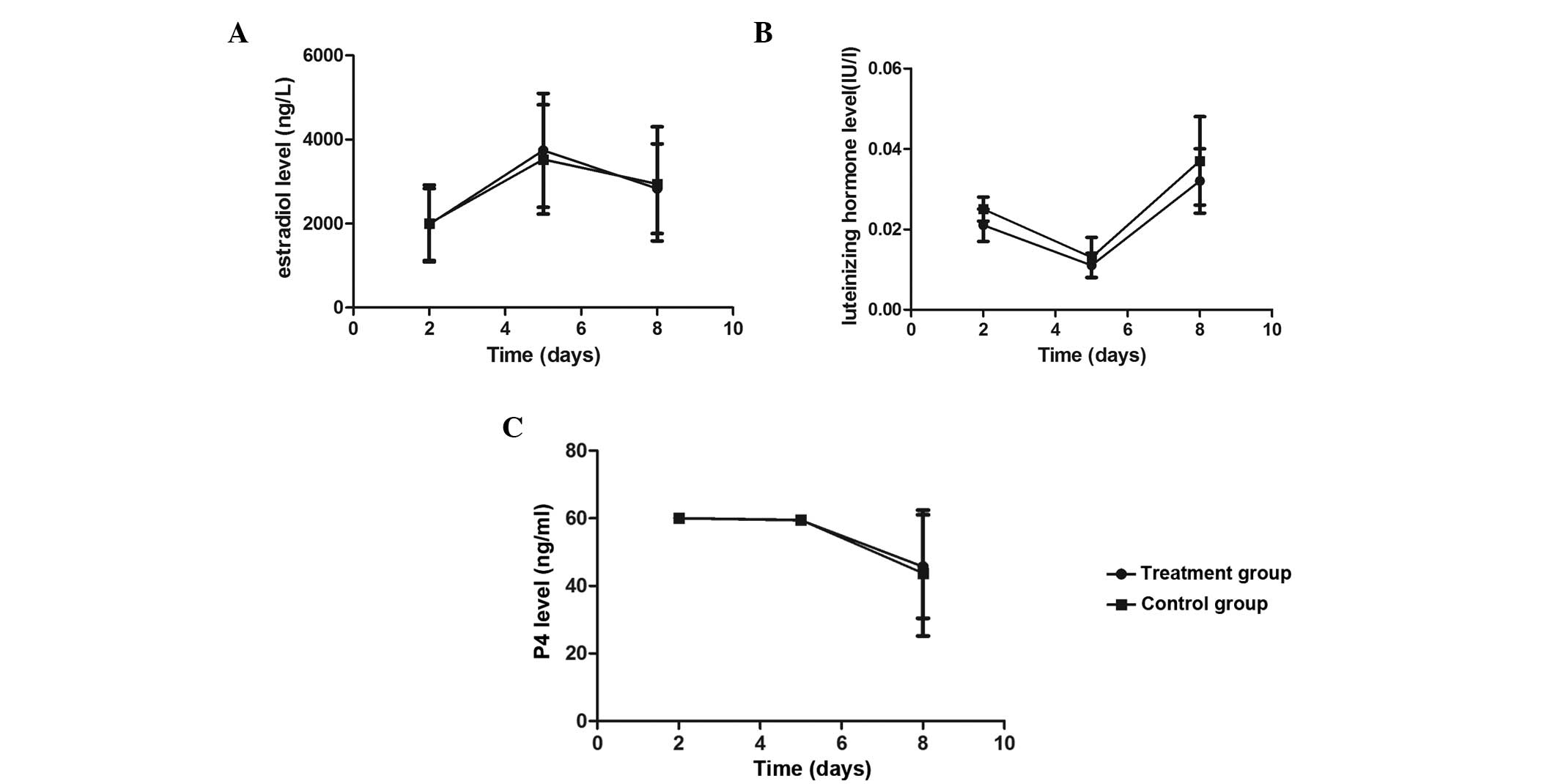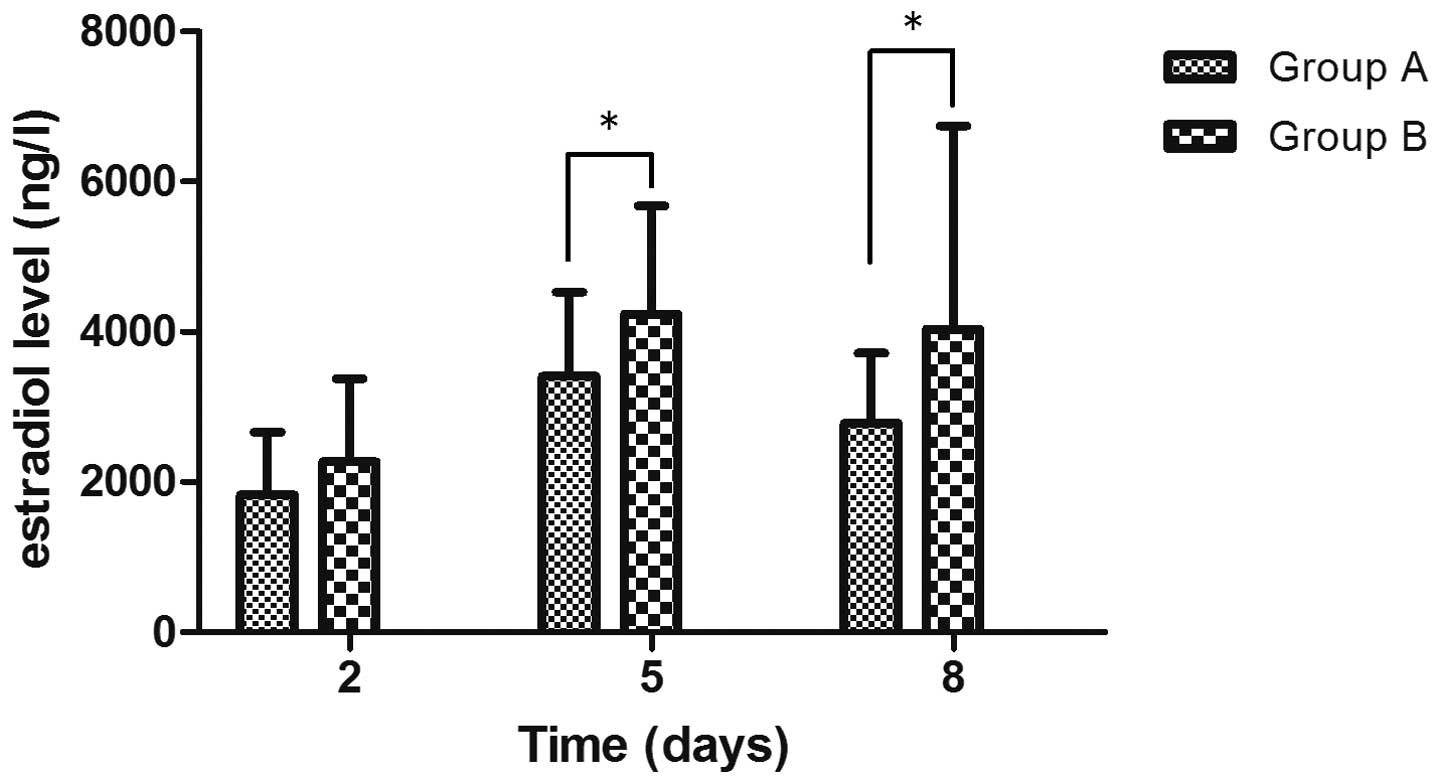|
1
|
Aboulghar M: Prediction of ovarian
hyperstimulation syndrome (OHSS). Estradiol level has an important
role in the prediction of OHSS. Hum Reprod. 18:1140–1141. 2003.
View Article : Google Scholar : PubMed/NCBI
|
|
2
|
Kamath MS, Joshi A, Kamath AM and Aleyamma
T: Management of severe ovarian hyperstimulation syndrome with
thawed plasma. J Hum Reprod Sci. 6:82–85. 2013. View Article : Google Scholar : PubMed/NCBI
|
|
3
|
de Mouzon J, Goossens V, Bhattacharya S,
Castilla JA, Ferraretti AP, Korsak V, Kupka M, Nygren KG and Nyboe
Andersen A: European IVF-monitoring (EIM) Consortium, for the
European Society of Human Reproduction and Embryology (ESHRE):
Assisted reproductive technology in Europe, 2006: results generated
from European registers by ESHRE. Hum Reprod. 25:1851–1862.
2010.
|
|
4
|
Gilliam ML: Gonadotrophin-releasing
hormone antagonists for assisted reproductive technology. Obstet
Gynecol. 118:706–707. 2011. View Article : Google Scholar : PubMed/NCBI
|
|
5
|
Lainas TG, Sfontouris IA, Zorzovilis IZ,
Petsas GK, Lainas GT and Kolibianakis EM: Management of severe
early ovarian hyperstimulation syndrome by re-initiation of GnRH
antagonist. Reprod Biomed Online. 15:408–412. 2007. View Article : Google Scholar : PubMed/NCBI
|
|
6
|
Bonilla-Musoles FM, Raga F, Castillo JC,
Sanz M, Dolz M and Osborne N: High doses of GnRH antagonists are
efficient in the management of severe ovarian hyperstimulation
syndrome. Clin Exp Obstet Gynecol. 36:78–81. 2009.PubMed/NCBI
|
|
7
|
Golan A, Ron-el R, Herman A, Soffer Y,
Weinraub Z and Caspi E: Ovarian hyperstimulation syndrome: an
update review. Obstet Gynecol Surv. 44:430–440. 1989. View Article : Google Scholar : PubMed/NCBI
|
|
8
|
Aboulghar MA and Mansour RT: Ovarian
hyperstimulation syndrome: classifications and critical analysis of
preventive measures. Hum Reprod Update. 9:275–289. 2003. View Article : Google Scholar : PubMed/NCBI
|
|
9
|
Gómez R, Soares SR, Busso C,
Garcia-Velasco JA, Simón C and Pellicer A: Physiology and pathology
of ovarian hyperstimulation syndrome. Semin Reprod Med. 28:448–457.
2010.
|
|
10
|
Egbase PE: Severe OHSS: how many cases are
preventable? Hum Reprod. 15:8–10. 2000. View Article : Google Scholar : PubMed/NCBI
|
|
11
|
Humaidan P, Quartarolo J and Papanikolaou
EG: Preventing ovarian hyperstimulation syndrome: guidance for the
clinician. Fertil Steril. 94:389–400. 2010. View Article : Google Scholar : PubMed/NCBI
|
|
12
|
Fatemi HM, Popovic-Todorovic B, Donoso P,
Papanikolaou E, Smitz J and Devroey P: Luteal phase oestradiol
suppression by letrozole: a pilot study in oocyte donors. Reprod
Biomed Online. 17:307–311. 2008. View Article : Google Scholar : PubMed/NCBI
|
|
13
|
Garcia-Velasco JA: How to avoid ovarian
hyperstimulation syndrome: a new indication for dopamine agonists.
Reprod Biomed Online. 18(Suppl 2): 71–75. 2009. View Article : Google Scholar : PubMed/NCBI
|
|
14
|
Gurgan T, Demirol A, Guven S, Benkhalifa
M, Girgin B and Li TC: Intravenous calcium infusion as a novel
preventive therapy of ovarian hyperstimulation syndrome for
patients with polycystic ovarian syndrome. Fertil Steril. 96:53–57.
2011. View Article : Google Scholar : PubMed/NCBI
|
|
15
|
Papanikolaou EG, Polyzos NP, Humaidan P,
Pados G, Bosch E, Tournaye H and Tarlatzis B: Aromatase inhibitors
in stimulated IVF cycles. Reprod Biol Endocrinol. 9:852011.
View Article : Google Scholar : PubMed/NCBI
|
|
16
|
Rollene NL, Amols MH, Hudson SB and
Coddington CC: Treatment of ovarian hyperstimulation syndrome using
a dopamine agonist and gonadotropin releasing hormone antagonist: a
case series. Fertil Steril. 92:1169.e15–1169.e17. 2009. View Article : Google Scholar : PubMed/NCBI
|
|
17
|
Al-Inany HG, Youssef MA, Aboulghar M,
Broekmans F, Sterrenburg M, Smit J and Abou-Setta AM:
Gonadotrophin-releasing hormone antagonists for assisted
reproductive technology. Cochrane Database Syst Rev.
CD0017502011.
|
|
18
|
Hill MJ, Chason RJ, Payson MD, Segars JH
and Csokmay JM: GnRH antagonist rescue in high responders at risk
for OHSS results in excellent assisted reproduction outcomes.
Reprod Biomed Online. 25:284–291. 2012. View Article : Google Scholar : PubMed/NCBI
|
|
19
|
Hosseini MA, Mahdavi A, Aleyasin A,
Safdarian L and Bahmaee F: Treatment of ovarian hyperstimulation
syndrome using gonadotropin releasing hormone antagonist: a pilot
study. Gynecol Endocrinol. 28:853–855. 2012. View Article : Google Scholar : PubMed/NCBI
|
|
20
|
Asimakopoulos B, Nikolettos N, Nehls B,
Diedrich K, Al-Hasani S and Metzen E: Gonadotropin-releasing
hormone antagonists do not influence the secretion of steroid
hormones but affect the secretion of vascular endothelial growth
factor from human granulosa luteinized cell cultures. Fertil
Steril. 86:636–641. 2006. View Article : Google Scholar
|
|
21
|
McDonough PG: Vascular endothelial growth
factor - mediator of OHSS? Fertil Steril. 79:1466–1467. 2003.
View Article : Google Scholar : PubMed/NCBI
|
|
22
|
Alvarez C, Alonso-Muriel I, García G,
Crespo J, Bellver J, Simón C and Pellicer A: Implantation is
apparently unaffected by the dopamine agonist Cabergoline when
administered to prevent ovarian hyperstimulation syndrome in women
undergoing assisted reproduction treatment: a pilot study. Hum
Reprod. 22:3210–3214. 2007. View Article : Google Scholar
|
|
23
|
Kosaka K, Fujiwara H, Yoshioka S and Fujii
S: Vascular endothelial growth factor production by circulating
immune cells is elevated in ovarian hyperstimulation syndrome. Hum
Reprod. 22:1647–1651. 2007. View Article : Google Scholar
|
|
24
|
Fridén BE and Nilsson L:
Gonadotrophin-releasing hormone antagonist luteolysis during the
preceding mid-luteal phase is a feasible protocol in ovarian
hyperstimulation before in vitro fertilization. Acta Obstet Gynecol
Scand. 84:812–816. 2005.
|
|
25
|
Duffy DM, Stewart DR and Stouffer RL:
Titrating luteinizing hormone replacement to sustain the structure
and function of the corpus luteum after gonadotropin-releasing
hormone antagonist treatment in rhesus monkeys. J Clin Endocrinol
Metab. 84:342–349. 1999.
|
|
26
|
Ortmann O, Weiss JM and Diedrich K: Embryo
implantation and GnRH antagonists: ovarian actions of GnRH
antagonists. Hum Reprod. 16:608–611. 2001. View Article : Google Scholar : PubMed/NCBI
|
















